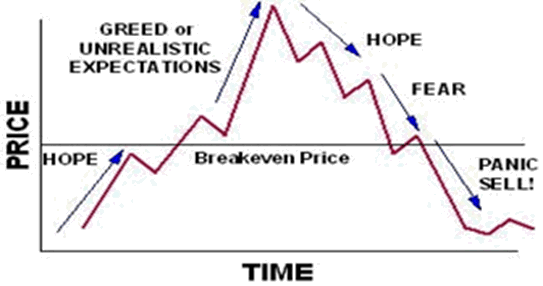| |
Marketing should be more than just selling. Marketing includes setting financial goals, assessing risk, exploring pricing and delivery alternatives, seeking market opportunities and keeping one’s pride in check.
Good marketing takes planning, selling discipline, access to good market information and a good understanding of pricing and delivery alternatives. Expecting to price everything at the market peak is unrealistic.
The Psychology of Marketing
Marketing requires pricing discipline to control pride. The greed-fear cycle in Figure 1 illustrates the typical reaction to an upward trending (bullish) market. As prices increase, some grain marketers hold back deliveries in an attempt to sell at the top. Once the market peaks and starts to decline, greed turns to hope that prices recover. During the hope phase producers still don’t sell. The market continues to fall and hope turns to fear. During the fear phase, farmers are still reluctant to sell, but the market fails to recover. As prices continue to fall, fear can turn to panic. Bills are due and cash grain must be sold.
Figure 1. Greed Fear Cycle

Planning to Market
- Know your costs of production - Before any pricing or marketing strategy can be developed, a farmer needs to know their breakeven prices, using realistic yield expectations. Pencil in a profit or, at least, family living costs above production costs to arrive at a minimum selling target.
- Spread sales over a 12 to 24 month period - The best marketers seldom incorporate the “all or nothing” approach of trying to hold everything and sell it all at the market peak. Spreading sales out allows farmers to target price into each of the three or four market rallies that occur in an average crop year.
- Avoid pricing during heavy delivery points - Prices slump during heavy delivery periods as commercial storage space tightens and basis levels weaken. A typically heavy delivery period to avoid is harvest, when many farmers make sales to conserve bin space and generate cash flow.
- Gather sources of information - When deciding to price, a variety of information sources should be used. Maintaining regular contact with local buyers, a cash grain broker, a commodity futures broker, and a market analyst will round out opinion to help make informed selling decisions. Participating in a marketing club is an excellent way to learn about marketing and develop information sources.
- Know your product - Market intelligence is useless unless it is combined with sound knowledge of what is for sale. Submitting representative samples from each bin to the Canadian Grain Commission (CGC) for quality assessment helps identify the market channels available to the farm manager. Then, shopping your sample around to various buyers will help you decide on the best way to market your crop.
|
|